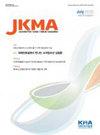皮肤药物不良反应
IF 0.5
Q3 MEDICINE, GENERAL & INTERNAL
引用次数: 0
摘要
背景:皮肤药物不良反应是常见的,并产生容易识别的临床症状。这些可能范围从轻度黄斑丘疹到与全身性疾病相关的严重反应。当前概念:药疹最常见的表现是黄斑丘疹或皮肤发疹,其次是固定药疹和荨麻疹。严重的皮肤药物不良反应包括Stevens-Johnson综合征/中毒性表皮坏死松解、急性全身性脓疱病、药物致过敏综合征/药物反应伴嗜酸性粒细胞增多和全身性症状,这些罕见但可能危及生命。最近,人们发现与新开发的药物(如表皮生长因子受体抑制剂)相关的皮肤不良反应可能诱发多种皮肤表现。讨论与结论:虽然某些药物,如抗菌剂和抗惊厥药,经常会引起药疹,但它们的效果可能会根据情况和时间而变化。因此,为了解决症状和预防并发症,应考虑到所涉及的各种因素,早期诊断,药物识别和适当的治疗。本文章由计算机程序翻译,如有差异,请以英文原文为准。
Cutaneous adverse drug reactions
Background: Cutaneous adverse drug reactions are common and produce easily identifiable clinical symptoms. These may range from mild maculopapular rashes to severe reactions associated with systemic disease.Current Concepts: The most common presentation of a drug eruption is in the form of a maculopapular rash or exanthematous skin eruption, followed by fixed drug eruptions and urticaria. Severe cutaneous adverse drug reactions include Stevens-Johnson syndrome/toxic epidermal necrolysis, acute generalized exanthematous pustulosis, and drug-induced hypersensitivity syndrome/drug reaction with eosinophilia and systemic symptoms, which are rare but potentially life-threatening. Recently, it has emerged that cutaneous adverse drug reactions associated with newly developed drugs, such as epidermal growth factor receptor inhibitors, may induce a variety of cutaneous manifestations.Discussion and Conclusion: Although certain drugs, such as antimicrobials and anticonvulsants, can frequently cause drug eruptions, their effects may change, depending on the situation and timing. Therefore, in order to resolve symptoms and prevent complications, early diagnosis, drug identification, and appropriate treatment should be performed, in consideration of the various factors involved.
求助全文
通过发布文献求助,成功后即可免费获取论文全文。
去求助
来源期刊

Journal of The Korean Medical Association
Medicine-General Medicine
CiteScore
0.50
自引率
0.00%
发文量
84
审稿时长
4-8 weeks
期刊介绍:
The Journal of the Korean Medical Association (JKMA) is the official peer-reviewed, open-access, monthly journal of the Korean Medical Association (KMA). It contains articles in Korean or English. Its abbreviated title is ''J Korean Med Assoc''. The aims of the Journal include contributing to the treatment of and preventing diseases of public health importance and to improvement of health and quality of life through sharing the state-of the-art scientific information on medicine by the members of KMA and other national and international societies.
 求助内容:
求助内容: 应助结果提醒方式:
应助结果提醒方式:


